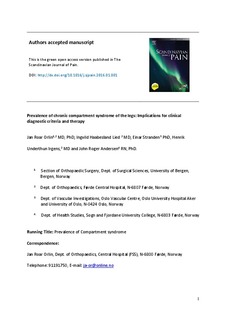| dc.description.abstract | Introduction
Poorly defined musculoskeletal disorders are a common clinical problem and have considerable psychosocial impact. Chronic compartment syndrome (CCS) of the legs has primarily been noted in young athletes and soldiers. The epidemiology of CCS in the general population has not been studied previously. The aim of this study was to establish the prevalence of CCS of the legs in the general population and to study its association with possible etiological factors.
Methods
A two-stage population survey was performed, using a questionnaire followed by clinical examination. A sample of 3000 individuals aged 25–75 years was randomly selected from the general population. A clinical examination was offered to those answering “Yes” to the following question: “Do you wake up at nights due to leg pains or cramps, causing you to walk around?” Intracompartmental pressures in the leg were measured in 13 persons randomly selected from among those diagnosed with CCS after the clinical examination.
Results
Of the 3000 persons contacted, 2308 (76.9%) responders were included in the study. Leg pain or cramps at night was reported by 24% of the respondents. Age, rheumatic disease, use of hormone medication, heart failure, leg oedema, and peripheral arterial disease were all significantly associated with leg pain or cramps (P < 0.05). Among 286 persons with leg pain who underwent a subsequent clinical examination, 91 persons (31.9%) were classified as definite CCS. This suggests a CCS prevalence of 7.6% in the total sample ([24% × 31.9%/100]). In 13 of the individuals with CCS intracompartmental pressure was measured before and after performance of the step test exercise. One individual had a post-exercise pressure >15 mmHg. None had post-exercise pressure past the conventional threshold of >30 mmHg.
Conclusion
Nocturnal leg pain or cramps is a common symptom. A significant part of the general population (7.6%) may have CCS of the legs, with symptoms ranging from very mild to severe.
Implications
Considering the high prevalence of CCS found in this study, it is likely that a large proportion of those presenting with muscular pain actually have CCS. These persons are usually advised to increase their physical training to achieve some degree of pain relief. However, CCS patients may instead experience both increased leg pain and a proximal myalgia, which is possibly a referred pain. A demanding “gold standard” test (requiring identification of elevated of intracompartmental pressures), unclear diagnostic criteria, poor long-term results from incomplete surgery, and an uncertain explanation for what may be termed referred pain seem to have delayed the acceptance of CCS as a common cause of leg pain/cramps and numbness. At the same time, the enormous costs to society and the reduced quality of life of patients require that such disease entities are correctly diagnosed as they can be effectively treated by simple, low-risk surgical procedures. | nb_NO |
